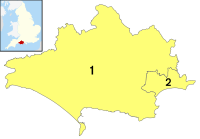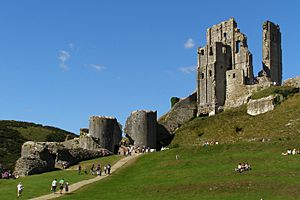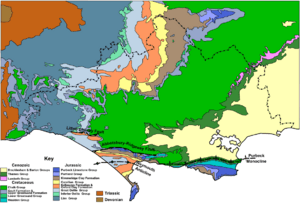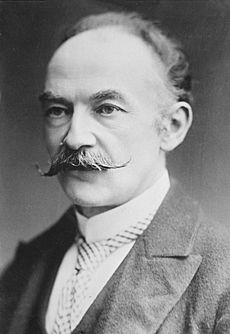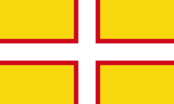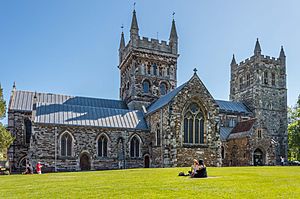Dorset facts for kids
Quick facts for kids
Dorset
|
|||||||||||||||||||||||||||||||||
|---|---|---|---|---|---|---|---|---|---|---|---|---|---|---|---|---|---|---|---|---|---|---|---|---|---|---|---|---|---|---|---|---|---|
|
|
|||||||||||||||||||||||||||||||||
 |
|||||||||||||||||||||||||||||||||
| Sovereign state | United Kingdom | ||||||||||||||||||||||||||||||||
| Constituent country | England | ||||||||||||||||||||||||||||||||
| Region | South West | ||||||||||||||||||||||||||||||||
| Established | Ancient | ||||||||||||||||||||||||||||||||
| Time zone | UTC±00:00 (Greenwich Mean Time) | ||||||||||||||||||||||||||||||||
| • Summer (DST) | UTC+01:00 (British Summer Time) | ||||||||||||||||||||||||||||||||
| Members of Parliament | List of MPs | ||||||||||||||||||||||||||||||||
| Police | Dorset Police | ||||||||||||||||||||||||||||||||
|
|||||||||||||||||||||||||||||||||
Dorset is a beautiful county in South West England. It has borders with Somerset, Wiltshire, Hampshire, and Devon. To the south, it meets the English Channel. The largest town in Dorset is Bournemouth, and the main county town is Dorchester.
Dorset covers about 2,653 square kilometers (1,024 square miles). Around half of its 772,268 people live in the big urban area called the South East Dorset conurbation. This area includes Bournemouth, Poole, and Christchurch. The rest of the county is mostly countryside with smaller towns like Weymouth and Dorchester. Dorset is split into two main local government areas: Bournemouth, Christchurch and Poole and Dorset.
The county has a very interesting landscape. You can find chalk hills, steep limestone ridges, and flat clay valleys. A big part of its coastline is famous as the Jurassic Coast World Heritage Site. This is because of its amazing rocks and fossils. Key spots include Lulworth Cove, the Isle of Portland, Chesil Beach, and Durdle Door. The highest point in Dorset is Lewesdon Hill, which is 279 meters (915 feet) tall.
People have lived in Dorset for a very long time, since the Stone Age. The Saxons settled here in the 7th century. The first ever Viking raid on Britain happened in Dorset in the 8th century. Later, the terrible Black Death arrived in England through Dorset in 1348. Dorset has also seen many important historical events, like parts of the English Civil War and the start of the trade union movement with the Tolpuddle Martyrs. Today, tourism is a major industry in Dorset.
Contents
Discovering Dorset's Name
Dorset gets its name from its county town, Dorchester. The Romans first set up a settlement here in the 1st century. They called it Durnovaria, which might have meant "place with fist-sized pebbles."
Later, the Saxons called the town Dornwaraceaster. The word -ceaster meant "Roman town." The people living in the area were called Dornsæte, combining Dorn (from Dorchester) and sæte (meaning "people"). The name Dorset was first written down in the 10th century.
Dorset's Rich History
Dorset has a long and exciting history, from ancient times to modern days.
Early Settlements and Roman Times
The first humans came to Dorset around 8000 BC. They were hunters during the Mesolithic period. The first people to settle down permanently arrived around 3000 BC. These Neolithic settlers built the Dorset Cursus, a 10.5-kilometer (6.5-mile) long monument likely used for special ceremonies.
Later, during the Bronze Age, farmers cleared forests for their fields. They also built many round barrows (burial mounds) on Dorset's high chalk hills. In the Iron Age, the Durotriges tribe built large hill forts, like Maiden Castle, which is one of the biggest in Europe.
The Romans arrived in AD 43. They captured Maiden Castle and built the town of Durnovaria nearby. A large ditch called Bokerley Dyke helped slow down the Saxons for about 150 years.
Saxon Rule and Viking Raids
By the end of the 7th century, Dorset became part of the Kingdom of Wessex. The Saxons set up a church center at Sherborne. Dorset became a "shire," which was an early form of an English county. Its borders have stayed mostly the same ever since.
In 789, the first recorded Viking attack in Britain happened on the coast of Portland in Dorset. Vikings continued to raid the county for the next two centuries.
Medieval Life and the Black Death
After the Normans took over in 1066, they built castles like Corfe, Wareham, and Dorchester. Dorset's population grew, and more land was used for farming.
The wool trade, stone quarrying, and busy ports like Weymouth and Lyme Regis brought wealth. However, in 1348, the Black Death arrived in Melcombe Regis (now part of Weymouth) on a ship from France. This terrible disease spread quickly and killed about a third of the country's population.
Modern History and Key Events
During the English Civil War in the 1640s, Dorset saw many battles. Corfe Castle, a Royalist stronghold, was captured and destroyed by Oliver Cromwell's army in 1646.
In 1685, the Monmouth Rebellion started when the Duke of Monmouth landed at Lyme Regis. This attempt to overthrow King James II failed. Afterward, harsh trials called the Bloody Assizes took place in Dorchester.
The 18th century saw a lot of smuggling along the Dorset coast. Poole became a very busy port, trading with places like Newfoundland. However, the Industrial Revolution mostly missed Dorset because it didn't have much coal. So, farming remained the main industry.
In 1834, six farm workers in Tolpuddle formed a union to protest low wages. These workers, known as the Tolpuddle Martyrs, were arrested and sent away. But huge protests led to their pardon, and they became important figures in the trade union movement.
During the Second World War, Dorset played a big role in preparing for the invasion of Normandy. Thousands of troops left from Portland and Poole harbours for D-Day.
After the war, Dorset became a popular place for holidays. Its beautiful coastline and countryside attract millions of visitors every year. Today, tourism is the county's biggest industry.
Towns and Villages of Dorset
Dorset is mostly rural, with many small villages and few large cities.
Major Urban Areas
The main urban area is the South East Dorset conurbation. This includes the popular seaside town of Bournemouth, the historic port of Poole, and the town of Christchurch. Bournemouth became popular in the 1700s when sea bathing became fashionable. Poole, which is next to Bournemouth, has areas like Sandbanks where land is very expensive.
Other Important Settlements
- Dorchester has been the county town since at least 1305.
- Weymouth is another major seaside resort.
- Blandford Forum, Sherborne, Gillingham, Shaftesbury, and Sturminster Newton are historic market towns in north Dorset.
- Bridport is in the west.
- Wareham and Wimborne Minster are historic Saxon market towns in the east.
- Lyme Regis and Swanage are small coastal towns popular with tourists.
There is also a new town called Poundbury being built near Dorchester. It was designed by King Charles III (when he was Prince of Wales) to mix homes and shops and reduce the need for cars.
Dorset's Natural Landscape
Dorset's varied landscape comes from its different types of rocks.
Hills, Valleys, and Heathland
Much of Dorset has chalk, clay, or sand and gravel. The county has several limestone ridges, often covered in fields or grasslands for sheep. These include the Cranborne Chase and the Dorset Downs.
Between the chalk hills are wide valleys like the Blackmore Vale and the Frome valley. The Blackmore Vale is known for dairy farming. South-east Dorset, around Poole and Bournemouth, has sandy and clay soils that support heathland. This heathland is home to all six native British reptile species and is very important for wildlife.
The far west of the county has a hilly landscape, similar to neighboring Devon. Lewesdon Hill (279 meters / 915 feet) and Pilsdon Pen (277 meters / 909 feet) are the two highest points in Dorset.
Harbours and Rivers
Poole Harbour is one of the largest natural harbors in the world. It was once a river valley that flooded about 6,000 years ago. The harbor has many islands, including Brownsea Island, where the Scouting movement began. Brownsea Island is also one of the last places in England where you can find native red squirrels.
Underneath Poole Harbour and the Isle of Purbeck is Western Europe's largest onshore oil field. Oil has been produced here since the 1960s.
Dorset has many rivers, but most are fairly calm. The main rivers are the Frome, Piddle, and Stour, which all flow towards the sea. The River Avon also enters Dorset near Christchurch.
The Famous Jurassic Coast
Most of Dorset's coastline is part of the Jurassic Coast, a World Heritage Site. This coast stretches for 155 kilometers (96 miles) and shows rocks from the entire Mesozoic era (Triassic to Cretaceous). It's famous for its amazing rock formations and fossils. Important fossils, like Jurassic trees and the first complete Ichthyosaur, were found here.
The coast features incredible landforms like Lulworth Cove (a perfect circular cove), Durdle Door (a natural rock arch), and Old Harry Rocks (chalk stacks). The Isle of Portland is a limestone island connected to the mainland by Chesil Beach. This 27-kilometer (17-mile) long shingle beach protects The Fleet, Britain's largest tidal lagoon.
Dorset has many conservation areas and two Areas of Outstanding Natural Beauty (AONBs), covering over half the county. The South West Coast Path, a long walking trail, starts in Dorset.
Dorset's Climate
| Weather chart for Weymouth, Dorset | |||||||||||||||||||||||||||||||||||||||||||||||
|---|---|---|---|---|---|---|---|---|---|---|---|---|---|---|---|---|---|---|---|---|---|---|---|---|---|---|---|---|---|---|---|---|---|---|---|---|---|---|---|---|---|---|---|---|---|---|---|
| J | F | M | A | M | J | J | A | S | O | N | D | ||||||||||||||||||||||||||||||||||||
|
84
9
5
|
61
9
4
|
58
11
5
|
52
13
7
|
45
16
9
|
46
18
12
|
41
20
14
|
55
20
14
|
55
19
13
|
83
16
10
|
99
12
7
|
92
10
5
|
||||||||||||||||||||||||||||||||||||
| temperatures in °C precipitation totals in mm source: Met Office, 1991–2020 |
|||||||||||||||||||||||||||||||||||||||||||||||
|
Imperial conversion
|
|||||||||||||||||||||||||||||||||||||||||||||||
Dorset has warm summers and mild winters because it's on Britain's south coast. It gets more sunshine than most of the UK, with 1,541–1,885 hours a year. The average annual temperature is between 9.8°C and 12°C (49.6°F and 53.6°F).
Rainfall varies across the county. Coastal areas get 700–800 mm (28–31 inches) per year. The Dorset Downs get more, between 1,000 and 1,250 mm (39–49 inches) per year.
Dorset's People
In 2011, Dorset's population was 744,041. More than half of these people live in the Bournemouth, Poole, and Christchurch area.
Dorset has more older people and fewer young people compared to the average for England and Wales. Life expectancy is also higher here. Most of Dorset's population (about 95.2%) are of white ethnicity. About 60.9% are Christian, and 28.5% say they are not religious.
Many people in Dorset have higher education qualifications. The main jobs are in professional or technical fields, administration, skilled trades, and customer service.
Dorset's Economy and Jobs
The main industry in Dorset used to be farming. However, as machines took over, fewer workers were needed. Farming has become less profitable and has declined.
Key Industries Today
- Tourism: This is now Dorset's biggest industry. It has grown a lot since the late 1700s. About 37,500 people work in tourism. In 2008, 3.2 million British and 326,000 foreign tourists visited Dorset. They spent over £1.4 billion. People love Dorset's coast and countryside.

- Manufacturing: This industry provides about 10.3% of jobs in Dorset. It's the county's fourth largest employer.
- Military: There are several military bases in Dorset, including the Royal Armoured Corps at Bovington Camp and the Royal Corps of Signals at Blandford Camp. These bases provide jobs for civilians.
- Ports: Dorset has three main ports: Poole, Weymouth, and Portland. These ports handle a lot of international trade and tourism. About 230 fishing boats that catch crab and lobster are based here.
- Marine Leisure: When Weymouth and Portland were chosen for the sailing events in the 2012 Summer Olympics, there was a lot of investment in the area. This has helped the marine leisure sector grow.
Other big employers in Dorset include BAE Systems, Sunseeker International, J.P. Morgan, Cobham plc, and Bournemouth University.
Dorset's Culture and Fun
Dorset, being a rural county, has many cultural attractions and events.
Arts and Museums
- Concerts and Theatre: Major venues include the Lighthouse arts centre in Poole, and the Bournemouth International Centre and Pavilion Theatre in Bournemouth. The Bournemouth Symphony Orchestra is based in Poole.
- Museums: Dorset has over 30 museums.
- The Dorset Museum in Dorchester has a huge collection about the county's history.
- The Tank Museum at Bovington is the largest museum in Dorset. It has over 300 tanks and armored vehicles.

-
- Other museums include The Keep Military Museum in Dorchester, the Russell-Cotes Museum in Bournemouth, and Poole Museum.
Historic Buildings and Sites
Dorset has many historic places:
- Over 1,500 scheduled monuments.
- 12,850 listed buildings.
- Grade I listed buildings include:
- Portland Castle, a fort built by Henry VIII.
- Corfe Castle, with over 1,000 years of history.
- A Roman ruin in Dorchester, the only one visible in Britain.
- Athelhampton, a Tudor manor house.
- Christchurch Priory, the longest church in England.
Festivals and Events
Dorset hosts many annual festivals:
- The Great Dorset Steam Fair near Blandford is one of Europe's largest events of its kind. It features old steam engines and machinery.
- The Bournemouth Air Festival is a free air show that attracts over a million visitors.
- The Dorset County Show celebrates Dorset's agriculture with local produce and livestock.
- Music festivals like Camp Bestival and Larmer Tree Festival are also held here.
Sports and Recreation
- Football: AFC Bournemouth is Dorset's only professional football club, playing in the Premier League.
- Cricket: Dorset County Cricket Club plays at Dean Park Cricket Ground in Bournemouth.
- Watersports: Dorset's coastline is great for sailing, windsurfing, and kayaking. The Weymouth and Portland National Sailing Academy hosted the sailing events for the 2012 Summer Olympics.
- Motorsport: Dorset also hosts the Extreme E Jurassic X Prix at Bovington Camp.
Literature and Local Dialect
Dorset is famous in literature because it's the home county of author and poet Thomas Hardy. Many places in his novels, set in the fictional Wessex, are in Dorset. You can visit Thomas Hardy's Cottage and Max Gate, his former home.
Other writers who lived in Dorset include Douglas Adams (who wrote The Hitchhiker's Guide to the Galaxy here) and John le Carré (born in Poole). Children's author Enid Blyton also found inspiration for her books in Dorset.
The 19th-century poet William Barnes wrote many poems in the old Dorset dialect. This dialect, which came from ancient Norse and Saxon languages, was once common in the Blackmore Vale but is now rarely used.
Dorset's Flag
Dorset has its own flag, called the Dorset Cross or St Wite's Cross. It was chosen in 2008 after a public competition. The flag has a white cross with a red border on a golden background.
- The red and white colors represent the Flag of England.
- The golden color stands for Dorset's sandy beaches, Golden Cap, and Gold Hill. It also refers to the Wessex Dragon, a symbol of the old Saxon Kingdom of Wessex.
Getting Around Dorset
Dorset has good transport links, though it doesn't have any motorways.
Railways
Two main railway lines connect Dorset to London:
- The West of England Main Line runs through northern Dorset, serving towns like Gillingham and Sherborne.
- The South West Main Line runs through southern Dorset, connecting Bournemouth, Poole, Dorchester, and Weymouth.
- The Heart of Wessex Line goes north from Weymouth to Bristol.
- The Swanage Railway is a special heritage steam and diesel railway that runs between Norden and Swanage.
Roads
Major roads in Dorset include the A303, A35, and A31.
- The A303 connects the West Country to London.
- The A35 crosses the county from west to east, passing through Bridport, Dorchester, Poole, and Bournemouth.
- The A31 connects to the A35 and goes east through Wimborne and Ferndown.
Ports and Airport
- Poole Harbour has ferries to Cherbourg in France and the Channel Islands.
- Portland Harbour and Poole Harbour can also handle large cruise ships.
- Bournemouth Airport, near Hurn, offers scheduled and charter flights.
Bus Services
- Morebus and Damory provide a wide bus network across the county.
- First Group operates buses in the Weymouth and Bridport area, including the Jurassic Coaster service along the coast.
Religious Sites in Dorset
Dorset does not have a cathedral, unlike its neighboring counties. Most of the county is part of the Church of England Diocese of Salisbury.
Christian Churches
- Early Churches: Christianity came to Dorset with the Romans. A 4th-century Roman mosaic found near Hinton St Mary shows an image of Christ. Few Saxon churches remain, but St. Martin's in Wareham is a good example from the early 11th century.
- Medieval Churches: Many churches from the Middle Ages are still standing, mostly from the 15th century.
- Sherborne Abbey is known for its beautiful fan vaulting. It was once a cathedral.
- Wimborne Minster has a chained library and a 14th-century astronomical clock.
- Christchurch Priory is famous for its "miraculous beam."
- St John the Baptist Church in Bere Regis has a beautiful 15th-century roof.
- St Candida and Holy Cross at Whitchurch Canonicorum is the only church in England (besides Westminster Abbey) with a saint's relics.
- Later Churches: After the Reformation, few new churches were built until the 18th century.
- St George's Church on the Isle of Portland has a steeple inspired by Christopher Wren.
- The Church of St Mary in East Lulworth was the first freestanding Roman Catholic church built in England after the Reformation.
- Bournemouth, founded in 1810, has many 19th-century churches like St Peter's.
- St Dunstan's in Poole is a rare example of 20th-century Neo-Byzantine style.
- The Church of St Nicholas and St Magnus in Moreton is known for its engraved glass windows by Laurence Whistler.
Other Faiths
Few places of worship exist for faiths other than Christianity. In 2008, a Hindu temple was built in Blandford Forum for the Gurkhas. Bournemouth has a higher number of Jewish residents than the national average, with three synagogues. It also has an Islamic Centre and a mosque.
Education in Dorset
Schools in Dorset are managed by two local education authorities: Dorset Council and Bournemouth, Christchurch and Poole (BCP) Council.
School System
- Most of the Dorset Council area uses a two-tier system: primary school followed by secondary school.
- Some areas, like Dorchester, use a three-tier system: first, middle, and high school.
- Bournemouth uses a two-tier system. Poole uses both two-tier and three-tier systems.
- BCP Council is one of the few areas in England with grammar schools. These are single-sex schools that select students based on an eleven-plus exam.
- Many schools in Dorset are now academies. These are state schools that are independent of the local authority.
Independent Schools
Dorset has several private independent schools. Many are boarding schools that also take day pupils. Examples include:
- Canford School, built around a 19th-century manor house.
- Sherborne School, a boys' school founded in the 16th century.
Colleges and Universities
- Further Education Colleges: Four of Dorset's largest towns have colleges, including Weymouth College and Bournemouth and Poole College.
- Higher Education: Dorset has two universities in the Bournemouth and Poole area:
- Bournemouth University has over 17,000 students. It became a university in 1992.
- The Arts University Bournemouth focuses on arts subjects. It became a university in 2012.
Images for kids
See also
 In Spanish: Dorset para niños
In Spanish: Dorset para niños





